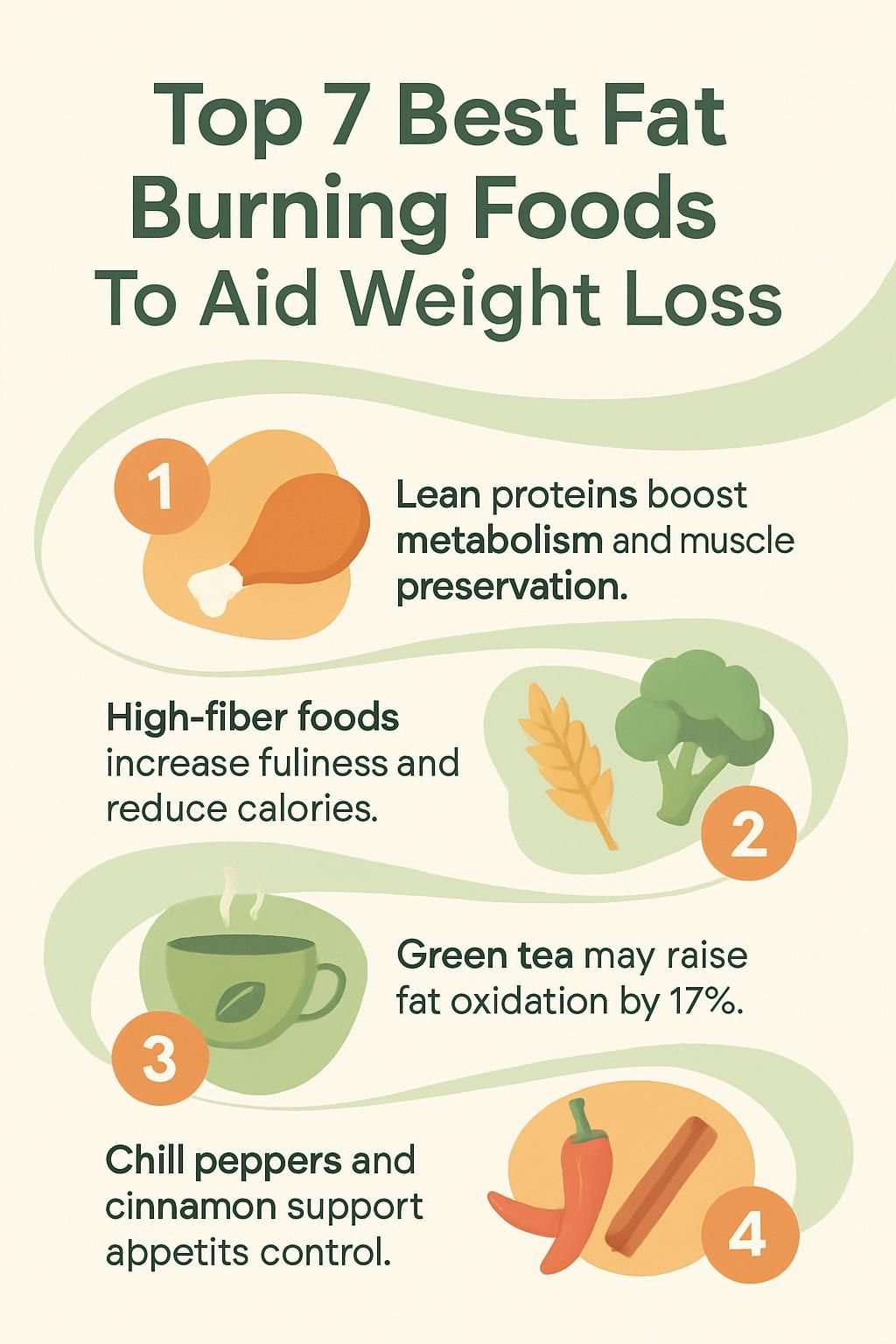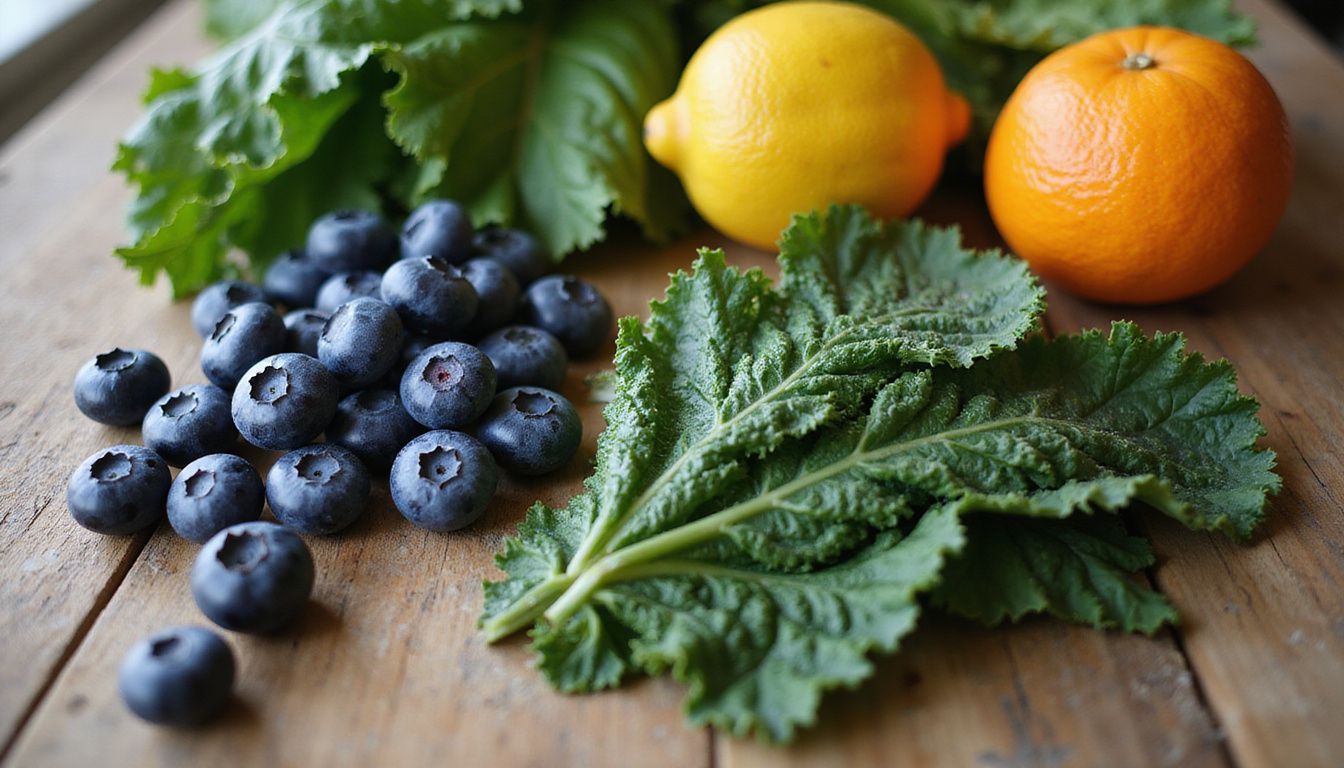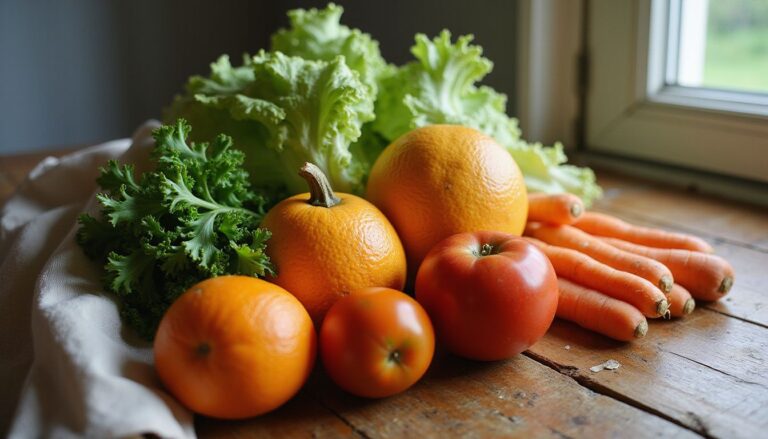Top 7 Best Fat Burning Foods To Aid Weight Loss
Our Nutrition Assistant AI Suite will transform your body. You will lose fat, get toned, and build muscle. Gain confidence and optimal health.
Trying to lose weight can feel hard and confusing. The right fat-burning foods help you burn fat, control hunger, and steady your energy. Small swaps make a big difference over time.
This guide shows you the best choices that support metabolism, reduce calories, and fit a healthy eating plan. You will see simple tips, clear reasons, and quick examples you can use today.
Key Takeaways
- Lean protein, such as chicken, turkey, eggs, and Greek yogurt, helps preserve muscle during weight loss and raises calorie burn through the thermic effect of food.
- High-fiber foods, including oatmeal, lentils, vegetables, fruit, and whole grains, increase fullness, which can lower total calorie intake.
- Green tea with catechins and black coffee may increase daily fat burning; some studies report up to a 17 percent rise in fat oxidation with green tea.
- Healthy fats from nuts, chia seeds, olive oil, and fatty fish add satiety and provide omega-3s that support heart health during calorie restriction.
- Spices such as chili peppers and cinnamon may boost thermogenesis and steady blood sugar, which can help with appetite control.

What Are Fat-Burning Foods?

Fat-burning foods are choices that help your body use more calories and support weight management. These foods often increase metabolism, which is the rate you burn energy, and they keep you full longer.
You get steady, usable energy and fewer cravings. That makes it easier to stick with a healthy diet and lose weight at a safe pace.
How does metabolism affect fat burning?
Metabolism is how your body turns food into energy. A higher metabolic rate means you burn more calories, even at rest. Muscle tissue burns more calories than body fat, so strength training helps you increase metabolism.
Hydration supports normal body function, including energy production. Age, genes, sleep, stress, and activity all affect your metabolic rate. Some foods, like green tea, contain catechins, which are plant compounds that may slightly raise calorie burn.
Regular movement plus balanced meals supports steady energy use. This approach helps you manage weight more effectively day to day.
A higher metabolic rate means your body burns more calories throughout the day, explains Dr. Lisa Young, registered dietitian.
On days you skip breakfast, energy can drop fast. A high-protein breakfast, such as eggs or Greek yogurt, can keep you full and active through the morning.
Which foods help with weight loss?
A faster metabolism helps your body use more fat for fuel. You can build meals with specific foods that support weight loss while staying satisfying.
- Choose lean protein like chicken, turkey, eggs, Greek yogurt, and fish to preserve muscle and support fat burning.
- Add high-fiber foods such as beans, lentils, oatmeal, whole grains, fruit, and vegetables to stay full longer.
- Include healthy fats from almonds, walnuts, chia seeds, olive oil, and fatty fish like salmon or sardines for satiety and omega-3s.
- Drink green tea or black coffee, both low in calories, to support metabolism and fat oxidation.
- Use chili peppers with capsaicin to promote thermogenesis, which is heat production that burns calories.
- Snack on berries, apples, pears, or grapefruit. Their water and fiber help fill you up with fewer calories.
- Eat nutrient-dense vegetables like broccoli and spinach to boost vitamins and fiber during weight-loss efforts.
For example, swap chips for a handful of blueberries or almonds. Pair that with eggs at breakfast and you will likely feel full between meals.
Greek Yogurt
Greek yogurt is high in protein and helps you stay full. Choosing plain versions keeps sugar low while supporting muscle during weight loss.
Why is Greek yogurt high in protein?
Greek yogurt is strained to remove liquid, so it has more protein per serving than regular yogurt. A cup usually provides about 15 to 20 grams, while many traditional yogurts provide 7 to 8 grams. More protein helps maintain muscle and raises the calories your body uses to digest food, called the thermic effect.
Dairy proteins can also help regulate hunger hormones such as PYY and GLP-1. This effect supports appetite control while you cut calories.
Greek yogurt also supplies potassium and calcium. These nutrients support healthy eating patterns and long-term weight control.
How does Greek yogurt help with fullness and muscle?
Protein slows stomach emptying, which keeps you satisfied longer. Greek yogurt has about twice the protein of regular yogurt, so it is a smart snack or breakfast base.
That protein also helps repair muscles after workouts. Keeping muscle while you lose weight helps you burn more calories all day.
Choose unsweetened options. Add fruit, cinnamon, or a few nuts for flavor without a big sugar hit.
Green Tea
Green tea contains catechins, a type of antioxidant. These plant compounds, plus natural caffeine, can help you burn fat while keeping total calories low.
What antioxidants and catechins does green tea have?
Green tea is rich in EGCG, which stands for epigallocatechin gallate. EGCG helps protect cells and may support fat metabolism. It appears in higher amounts in green tea compared with many black teas.
Other catechins include ECG, EGC, and EC. Together with caffeine, they may help your body use fat for energy more efficiently.
Switching a sugary drink for green tea can steady your energy through the day. It is a simple change that also cuts added sugar.
How does green tea naturally boost metabolism?
EGCG and caffeine work together to increase calorie burn. EGCG may raise fat oxidation at rest. Caffeine can help you use more fat for fuel, especially during activity.
Research suggests 2 to 3 cups of unsweetened green tea per day may aid weight management. Many people find it satisfying between meals as a low-calorie drink.
Choose it in place of sugary beverages. Spread servings through the day for steady effects.
Chili Peppers
Chili peppers add heat and may support fat loss. Spicy meals can increase calorie burn briefly and help curb appetite for some people.
How does capsaicin promote thermogenesis?
Capsaicin is the compound that makes peppers hot. After a capsaicin-rich meal, your core temperature may rise slightly. That heat production, called thermogenesis, increases calorie use for a short period.
Research shows the effect is stronger with higher amounts of capsaicin. Very hot varieties, such as habanero, tend to produce a bigger bump in calorie burn than milder peppers.
You might notice warmth or light sweating after spicy food. That is a sign your body is using extra energy in that moment.
Can chili peppers reduce appetite?
Studies in the American Journal of Clinical Nutrition report that capsaicin can increase fullness and reduce calorie intake at a meal. These benefits may help people with obesity or type 2 diabetes manage hunger.
Capsaicin can be part of meals that also include protein and fiber, such as a bowl with lean meat and brown rice. Many people feel satisfied faster when spice is present, which can make portion control easier.
Sensitivity differs from person to person. Start with small amounts to see how your body responds.
Lean Protein Sources
Lean protein keeps you full and protects muscle while you lose weight. Pair it with vegetables and whole grains for balanced meals that support fat loss.
Why are eggs nutrient-dense for weight loss?
One large egg has about 75 calories and 7 grams of high-quality protein. Eggs also provide vitamin D, choline, and selenium. These nutrients support metabolism and overall health.
Protein from eggs helps manage hunger between meals. Research shows higher protein intake can reduce appetite and increase fullness.
Hard-boiled eggs make an easy breakfast or snack. They fit into a calorie-controlled plan without much prep time.
How do chicken and turkey provide low-fat protein?
Skinless chicken breast and turkey breast are rich in protein and low in saturated fat. A 3 to 4 ounce portion of chicken provides around 25 grams of protein with minimal fat.
Grilling or broiling keeps added calories low. Protein has a higher thermic effect than carbs or fat, so your body uses more energy to digest it.
Use 3 to 4 ounces as a simple portion guide. Swap higher-fat meats for grilled chicken or turkey in salads, soups, wraps, or stir-fries.
What omega-3 benefits do fish offer?
Fatty fish such as salmon, sardines, herring, and mackerel supply omega-3 fatty acids. Omega-3s are essential fats that support heart health and may help preserve muscle while reducing body fat percentage.
The American Heart Association suggests at least two 3-ounce servings per week. Fish is also satisfying because it provides high-quality protein that digests more slowly than refined carbs.
If you do not eat fish, consider an omega-3 supplement after checking with your healthcare provider.
Whole Grains
Whole grains provide steady energy and help stabilize blood sugar. They also add fiber, which supports fullness and healthy digestion.
How does oatmeal’s fiber promote fullness?
Oatmeal contains soluble fiber that absorbs water and swells in your stomach. This action slows digestion and helps keep blood sugar steady. You feel full longer and snack less.
Cooked oats provide about 4 grams of fiber per cup. Hot oatmeal often takes longer to eat than cold cereal, which can reduce overeating.
Prepare oats hot or make overnight oats for busy mornings. Add fruit or cinnamon for flavor without a calorie spike.
Why is quinoa a complete protein with essential nutrients?
Quinoa is a complete protein, which means it contains all nine essential amino acids your body cannot make. One cooked cup provides about 8 grams of protein and 5 grams of fiber.
It also supplies iron, zinc, selenium, and vitamin E. These nutrients support energy, immune function, and healthy skin.
Quinoa cooks fast and works well in bowls, salads, or as a side. It is naturally gluten-free and helps meals feel more satisfying.
Fruits That Support Weight Loss
Many fruits are rich in water and fiber and are low in calories. They make smart snacks that save calories but still satisfy.
How does grapefruit enhance fat metabolism?
Grapefruit provides soluble fiber and a high water content, which increases fullness. Eating half a grapefruit or drinking a small glass of grapefruit juice before meals can reduce the calories you eat at that meal.
Some studies link regular grapefruit intake to better appetite control and metabolic health. It is filling, hydrating, and very low in calories.
Add grapefruit segments to salads or pair with a protein-rich breakfast for longer satiety.
Why do apples and pears help with hydration and fiber intake?
Apples and pears are about 84 percent water, so they help with hydration. Most of their fiber lies in the peel, so eat the skin when possible. A medium apple or pear provides around 4 to 5 grams of fiber.
These fruits take time to chew, which slows eating and aids fullness. They are easy to pack for work or school, and they help cut back on sugary snacks.
Blend sliced apple with a protein shake for a filling post-workout breakfast.
What makes berries good for weight loss?
Berries such as blueberries are low in calories and high in fiber, so they help control hunger. They also provide antioxidants, which protect your cells from damage.
Frozen berries without added sugar are convenient and budget-friendly. Use them in smoothies, on oatmeal, or as a sweet snack.
Their natural sweetness makes a smart trade for dessert. That small switch can reduce added sugar and support weight control.
Nuts and Seeds
Nuts and seeds add healthy fats and fiber to meals. They improve fullness and make it easier to stick with a calorie target.
Why are almonds a healthy fat choice?
Almonds supply monounsaturated fat, protein, and fiber, a trio that keeps you satisfied. An ounce also provides vitamin E and magnesium.
Studies show people who include nuts often manage body weight better than those who avoid them. A small handful works well as a snack or salad topper.
Keep a portion nearby for mid-afternoon cravings. The mix of fat and protein helps control hunger between meals.
How do chia seeds provide fiber and omega-3s?
Chia seeds deliver about 10 grams of fiber per ounce. This fiber absorbs liquid and forms a gel, which slows digestion and keeps you full.
They also provide plant-based omega-3s, mainly ALA, which supports heart health. Sprinkle chia on oatmeal, yogurt, or smoothies for a fast nutrient boost.
Start with a teaspoon and increase slowly. Let chia sit in liquid for a few minutes if you prefer a softer texture.
Beverages That Aid Fat Burning
Some drinks can support fat loss and steady energy. Choose options that are low in calories and high in benefits.
How does black coffee increase energy and metabolism?
Coffee contains caffeine, a stimulant that can raise energy and slightly increase daily calorie burn. Black coffee is nearly calorie-free, which makes it a better choice than cream-heavy drinks.
Most healthy adults can have up to 400 milligrams of caffeine per day, which is about 4 to 5 cups depending on brew strength. Caffeine can also help your body use stored fat for fuel.
If you feel jittery, reduce the amount. Pair coffee with water to stay hydrated.
Can apple cider vinegar help regulate blood sugar?
Apple cider vinegar contains acetic acid, which may slow stomach emptying and reduce spikes in blood sugar after meals. This effect can support appetite control and may help with belly fat in some studies.
Try 1 teaspoon in a glass of water before a meal, then increase to 1 tablespoon if you tolerate it well. Use it in salad dressings for a simple way to add flavor.
Avoid drinking it straight since it can irritate your throat and teeth. Check with your clinician if you take diabetes or heart medicines.
Vegetables for Weight Loss
Vegetables add bulk, water, and fiber with very few calories. They make meals bigger and more satisfying without a calorie hit.
Why is broccoli low calorie and high in fiber?
Broccoli is about 90 percent water and provides only 31 calories per cup. One serving has roughly 2.4 grams of fiber, which supports fullness and healthy digestion.
It also contains vitamin C, vitamin K, folate, potassium, and iron. Enjoy it steamed, roasted, or raw in salads and soups.
Non-starchy vegetables like broccoli are easy to include in calorie-controlled plans.
How does spinach support digestion and nutrition?
Spinach provides about 2 grams of fiber per cup and has a high water content. This combination adds volume to meals and supports regularity.
It is rich in vitamin K, vitamin A, folate, iron, and magnesium. One cup has only about 7 calories, so it is a low-calorie way to boost nutrition.
Add spinach to smoothies, omelets, grain bowls, or serve it lightly steamed with lean protein.
Spices That Accelerate Fat Burning
Spices make healthy food taste great. A few also support blood sugar control and a small rise in calorie burn.
How does cinnamon help control blood sugar?
Cinnamon may improve insulin sensitivity, which helps your body use glucose more effectively. Some research suggests it can lower fasting blood sugar in people with type 2 diabetes.
Sprinkle cinnamon on oatmeal, yogurt, or coffee. It adds flavor without extra sugar or calories.
Stable blood sugar can mean fewer cravings and steadier energy through the morning.
What metabolism benefits does turmeric offer?
Turmeric contains curcumin, an antioxidant studied for its role in metabolism and inflammation control. Early research suggests curcumin may help with fat processing and metabolic balance.
Add turmeric to soups, curries, or smoothies. Start with half a teaspoon and adjust to taste.
Scientists continue to study the best amounts for weight support. Use turmeric as a flavor tool as you build a healthy plate.
Tips for Incorporating Fat-Burning Foods into Your Diet
A few smart habits help you use these foods every day. Build simple meals, plan snacks, and keep your kitchen stocked.
How can you create balanced meals with fat-burning foods?
Build plates with three parts: a lean protein, a high-fiber carb, and vegetables. Add a small portion of healthy fat for fullness.
- Protein: chicken, turkey breast, eggs, Greek yogurt, beans, or fish
- Fiber carbs: oatmeal, quinoa, brown rice, whole-grain pasta, or beans
- Vegetables: broccoli, spinach, peppers, or mixed greens
- Healthy fats: almonds, chia seeds, olive oil, or fatty fish
Use spices like cinnamon or turmeric for flavor and blood sugar support. Drink water, green tea, or black coffee to keep calories low.
Why combine these foods with exercise for best results?
Strength training builds lean muscle, which burns more calories at rest than fat. Cardio helps create a calorie deficit that supports fat loss.
Food and movement work best together. A protein-rich snack after training, such as Greek yogurt with berries, supports recovery and keeps you full.
Check with your healthcare provider before starting a new program, especially if you have medical conditions or take medication.
Conclusion
Choosing fat-burning foods can help you burn fat, control hunger, and protect muscle while you lose weight. Focus on Greek yogurt, lean proteins, whole grains, green tea, fruit, vegetables, nuts, and seeds. Add spices like cinnamon and chili peppers, and choose low-calorie drinks that support metabolism.
These steps aid weight loss and fit into daily life. Pair them with regular activity and speak with a qualified clinician if you have health concerns or use prescription medicine.
FAQs
1. What are the top seven best fat burning foods to aid weight loss?
The top seven foods that support fat loss include salmon, eggs, Greek yogurt, green tea, chili peppers, leafy greens like spinach and kale, and whole grains such as oats or brown rice. These choices contain nutrients that boost metabolism or promote fullness.
2. How do these foods help burn body fat?
These foods often have high protein or fiber content which increases satiety and reduces overall calorie intake. Some options like green tea and chili peppers may raise metabolic rate due to compounds such as catechins or capsaicin according to research from Harvard Health Publishing (2019).
3. Can eating these foods alone guarantee weight loss?
Eating only these items will not ensure weight reduction without a balanced diet and regular physical activity. Studies show combining healthy food with exercise leads to more sustainable results than dietary changes alone (National Institutes of Health, 2020).
4. Is there scientific evidence supporting the effectiveness of these fat burning foods?
Yes; multiple studies confirm their benefits for metabolism and appetite control. For example, a study published in The American Journal of Clinical Nutrition found that people who consumed higher amounts of protein-rich food experienced greater reductions in body mass compared to those on lower-protein diets.
Summary: Choosing nutrient-dense options like fish, eggs, dairy products low in sugar but high in protein, certain teas, spicy vegetables such as hot peppers along with leafy greens and whole grains can help manage hunger while boosting your body’s ability to use energy efficiently during weight management efforts.
Personal Note: I included more leafy greens after reading about their effects on fullness; it helped me avoid unnecessary snacking between meals which made sticking to my nutrition plan easier over time.







